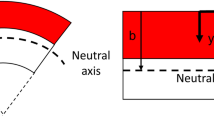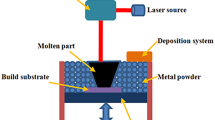Abstract
This work presents an analytical modeling methodology for the prediction of part distortion in powder bed metal additive manufacturing (PBMAM). The presented model consists of analytical thermal modeling, thermal stress modeling, residual stress modeling, and distortion modeling. It has promising short computational efficiency without resorting to finite element analysis or any iteration-based simulations. The temperature profile is calculated using a moving point heat source solution and heat sink solution with consideration of heat input from a moving laser and heat loss from boundary heat transfer. The thermal stress is calculated from the temperature calculation using a thermal stress model considering thermal load, surface tension, and hydrostatic pressure. The residual stress is calculated from the thermal stress calculation using an elastoplastic relaxation procedure. The residual stress–induced part distortion is finally calculated from the calculated residual stress and residual strain using a surface displacement model. The calculated part distortion was validated to experimental measurement on a twin-cantilever part produced by PBMAM of Ti6Al4V. Close agreements were observed. The computational time was recorded less than 10 s. The high predictive accuracy and high computational efficiency allow the process parameter planning for distortion control and elimination through inverse analysis.










Similar content being viewed by others
References
Frazier WE (2014) Metal additive manufacturing: a review. J Mater Eng Perform 23(6):1917–1928
Mani M, Lane BM, Donmez MA, Feng SC, Moylan SP (2017) A review on measurement science needs for real-time control of additive manufacturing metal powder bed fusion processes. Int J Prod Res 55(5):1400–1418
Biegler M, Graf B, Rethmeier M (2018) In-situ distortions in LMD additive manufacturing walls can be measured with digital image correlation and predicted using numerical simulations. Addit Manuf 20:101–110
Heigel JC, Michaleris P, Palmer TA (2015) In situ monitoring and characterization of distortion during laser cladding of Inconel® 625. J Mater Process Technol 220:135–145
Dunbar AJ, Denlinger ER, Gouge MF, Michaleris P (2016) Experimental validation of finite element modeling for laser powder bed fusion deformation. Addit Manuf 12:108–120
Afazov S, Denmark WA, Toralles BL, Holloway A, Yaghi A (2017) Distortion prediction and compensation in selective laser melting. Addit Manuf 17:15–22
Denlinger ER, Michaleris P (2016) Effect of stress relaxation on distortion in additive manufacturing process modeling. Addit Manuf 12:51–59
Zaeh MF, Branner G (2010) Investigations on residual stresses and deformations in selective laser melting. Prod Eng 4(1):35–45
Li C, Fu CH, Guo YB, Fang FZ (2016) A multiscale modeling approach for fast prediction of part distortion in selective laser melting. J Mater Process Technol 229:703–712
Li C, Guo Y, Fang X, Fang F (2018) A scalable predictive model and validation for residual stress and distortion in selective laser melting. CIRP Ann 67(1):249–252
Paul R, Anand S, Gerner F (2014) Effect of thermal deformation on part errors in metal powder based additive manufacturing processes. J Manuf Sci Eng 136(3):031009
Ning J, Nguyen V, Liang SY (2019) Analytical modeling of machining forces of ultra-fine-grained titanium. Int J Adv Manuf Technol 101(1–4):627–636
Ning J, Nguyen V, Huang Y, Hartwig KT, Liang SY (2019) Constitutive modeling of ultra-fine-grained titanium flow stress for machining temperature prediction. Bio-Des Manuf 2:153–160
Li F, Ning J, Liang SY (2019) Analytical modeling of the temperature using uniform moving heat source in planar induction heating process. Appl Sci 9(7):1445
Van Elsen M, Baelmans M, Mercelis P, Kruth JP (2007) Solutions for modelling moving heat sources in a semi-infinite medium and applications to laser material processing. Int J Heat Mass Transf 50(23–24):4872–4882
Ning J, Sievers DE, Garmestani H, Liang SY (2019) Analytical modeling of in-process temperature in powder bed additive manufacturing considering laser power absorption, latent heat, scanning strategy, and powder packing. Materials 12(5):808
Ning J, Sievers DE, Garmestani H, Liang SY (2019) Analytical thermal modeling of metal additive manufacturing by heat sink solution. Materials 12(16):2568
Ning J, Mirkoohi E, Dong Y, Sievers DE, Garmestani H, Liang SY (2019) Analytical modeling of 3D temperature distribution in selective laser melting of Ti-6Al-4V considering part boundary conditions. J Manuf Process 44:319–326
Ning J, Sievers DE, Garmestani H, Liang SY (2019) Analytical modeling of transient temperature in powder feed metal additive manufacturing during heating and cooling stages. Appl Phys A 125(8):496
Ning J, Sievers DE, Garmestani H, Liang SY (2019) Analytical modeling of in-process temperature in powder feed metal additive manufacturing considering heat transfer boundary condition. Int J Precis Eng Manuf-Green Technol 1–9
Ning J, Wang W, Zamorano B, Liang SY (2019) Analytical modeling of lack-of-fusion porosity in metal additive manufacturing. Appl Phys A 125(11):797
Ning J, Sievers DE, Garmestani H, Liang SY (2020) Analytical modeling of part porosity in metal additive manufacturing. Int J Mech Sci 105428
Fergani O, Berto F, Welo T, Liang SY (2017) Analytical modelling of residual stress in additive manufacturing. Fatigue Fract Eng Mater Struct 40(6):971–978
Ning J, Sievers DE, Garmestani H, Liang SY (2020) Analytical modeling of in-situ deformation of part and substrate in laser cladding additive manufacturing of Inconel 625. J Manuf Process 49:135–140
Sadik S, Yavari A (2017) Geometric nonlinear thermoelasticity and the time evolution of thermal stresses. Math Mech Solids 22(7):1546–1587
Saif MTA, Hui CY, Zehnder AT (1993) Interface shear stresses induced by non-uniform heating of a film on a substrate. Thin Solid Films 224(2):159–167
McDowell DL (1997) An approximate algorithm for elastic-plastic two-dimensional rolling/sliding contact. Wear 211(2):237–246
Love AEH (1952) A treatise on the mathematical theory of elasticity. Cambridge university press
Roberts IA, Wang CJ, Esterlein R, Stanford M, Mynors DJ (2009) A three-dimensional finite element analysis of the temperature field during laser melting of metal powders in additive layer manufacturing. Int J Mach Tools Manuf 49(12–13):916–923
Yang Y, Knol MF, Van Keulen F, Ayas C (2018) A semi-analytical thermal modelling approach for selective laser melting. Addit Manuf 21:284–297
Heigel JC, Michaleris P, Reutzel EW (2015) Thermo-mechanical model development and validation of directed energy deposition additive manufacturing of Ti–6Al–4V. Addit Manuf 5:9–19
Yadroitsev I, Yadroitsava I (2015) Evaluation of residual stress in stainless steel 316L and Ti6Al4V samples produced by selective laser melting. Virtual Phys Prototyp 10(2):67–76
Ning J, Liang SY (2018) Model-driven determination of Johnson-cook material constants using temperature and force measurements. Int J Adv Manuf Technol 97(1–4):1053–1060
Ning J, Liang SY (2019) Inverse identification of Johnson-cook material constants based on modified chip formation model and iterative gradient search using temperature and force measurements. Int J Adv Manuf Technol 102(9–12):2865–2876
Funding
This research project was financially supported by The Boeing Company.
Author information
Authors and Affiliations
Corresponding authors
Ethics declarations
Conflict of interest
The authors declare that they have no conflict of interest.
Additional information
Publisher’s note
Springer Nature remains neutral with regard to jurisdictional claims in published maps and institutional affiliations.
Rights and permissions
About this article
Cite this article
Ning, J., Praniewicz, M., Wang, W. et al. Analytical modeling of part distortion in metal additive manufacturing. Int J Adv Manuf Technol 107, 49–57 (2020). https://doi.org/10.1007/s00170-020-05065-8
Received:
Accepted:
Published:
Issue Date:
DOI: https://doi.org/10.1007/s00170-020-05065-8




